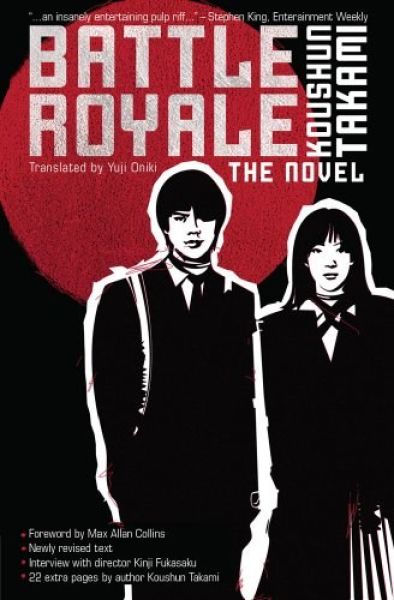Haikasoru 2: Battle Royale: The Novel by Koushun Takami (Trans. Yuji Oniki)
Battle Royale: The Novel
By Koushun Takami (Translated by Yuji Oniki)

14 May, 2011
0 comments
Battle Royale: The Novel
Koushun Takami (Trans. Yuji Oniki)
VIZ/Haikasoru
$16.99 USA/$23.00 CAN/£9.99
608 pages
ISBN: 978 – 1421527727
I was going to assert that this is one of the books published by VIZ pre-Haikasoru but I see this is a revised text from 2009, one that includes an introduction by Max Allan Collins, an interview with director Kini Fukasaku and an afterword by Koushub Takami.
This is one of those books whose craft I can admire without in any way enjoying the experience of reading it.
Of course I knew it would be; the only reason I picked it up is because I want to read and review the complete Haikasoru line.
It’s also one of those books where I encountered the movie adaptation before I encountered the book itself; be warned that there are significant differences between book and movie. There’s also a manga, which I have not seen.
In an alternate history where Japan was on the winning side of the Pacific War, the Republic of Greater East Asia controls a considerable portion of Asia and of humanity. It is willfully isolated, eschewing contact with the outside world when possible, and brutally authoritarian. One of the ways the government keeps people too cowed to rise up is the Program, supposedly a military research project1. Once a year, a class of school children is selected, kidnapped, and dumped on an island where they will be forced to fight to the last survivor. All of the subjects are outfitted with explosive tracking collars (collars that also include a listening device); willful non-participants can be executed with a radio signal, as can students trying to escape the island. If at the end of three days more than one student survives, all of the survivors will be executed.
The book begins as the latest group is kidnapped. Two students are killed during the briefing to get the point across that this really is to the death2; the survivors are given weapons or at least tools of varying degrees of utility (ranging from automatic weapons to a fan) and sent out into the island ruins and forests. As one would expect from a large group, one can finds extremes of adaptivity, ranging from those whose principles are firm enough that they absolutely refuse to be bullied into becoming killers to those who enthusiastically leap on the opportunity to massacre their peers. As a result, the population on the island plummets: by page 209, 25 of the original 42 students are left.
This isn’t one of those books where the youthful protagonist manages to overthrow a corrupt society; protagonist Shuya Nanahara and significant secondary characters Noriko Nakagawa and Shogo Kawada will be hard pressed to stay alive as long as possible, never mind grander goals. Do not get too attached to the lesser characters; the events in the book develop not necessarily to their advantage (but on the plus side, some of the people who get killed get killed while actively trying to kill others and not just because the people in power have done their best not to give them a choice in the matter).
Just as the the Republic of Greater East Asia’s efforts to keep American influences from contaminating the population are ultimately ineffective, so too are their attempts to brutalize their childen. Some prefer to kill themselves in protest and others opt for high-risk strategies to oppose the Program. This is a fairy grim book but not one without occasional moments of hope, even if it’s just small scale hope.
What I learned from this book is that I don’t want to read about kids being forced to kill each other and certainly not for over six hundred pages. What I’ve learned from books like The Hunger Games trilogy3 and the upcoming Divergent is that I am not going to get a choice; Young Adult Dystopias are all the rage these days. Imagine my joy.
If by some chance you have some goal that can be facilitated by reading about schoolchildren being forced to kill or be killed (or kill and be killed), then I recommend this book to you. I am not in this group but I can see that the author achieves the goals he set for himself; this is the book he meant to write, not a clumsy approximation.
1: There are hints that the main reason the Program continues isn’t because it’s seen as particularly effective but because in an authoritarian regime it’s difficult to get rid of bad ideas that originated from the top.
2: When I watched the movie years ago, the first (?) death is when a chatty schoolgirl gets a knife in the forehead, which is the exact point when I discovered that my indifference to movie violence doesn’t extend to kids being killed. Who knew?
3: We probably need to deal with the spot on the x‑ray presented by the remarkable similarities between Battle Royale and Hunger Games . Suzanne Collins says she has not read Battle Royale , the book of which Collins’ book appear to be a blatant rip off and I am inclined to believe her for three reasons. Firstly, this sort of parallel development is not unheard: see Fountains of Paradise and The Web Between the Worlds . Secondly, there’s a tradition in mainstream of writing SF without bothering to see if there are precidents in SF. Thirdly, America is an insular nation whose inhabitants are generally unfamiliar with other lands and it beggars belief that a random American author would happen to be one of the minority who bother to be aware of foreign entertainments.
